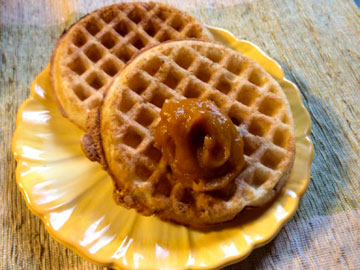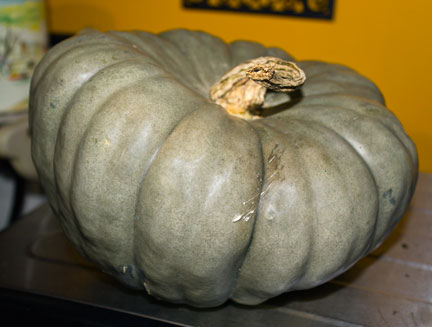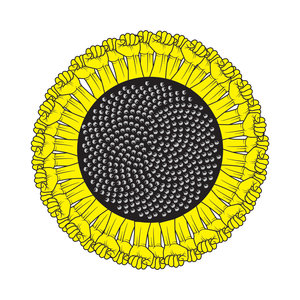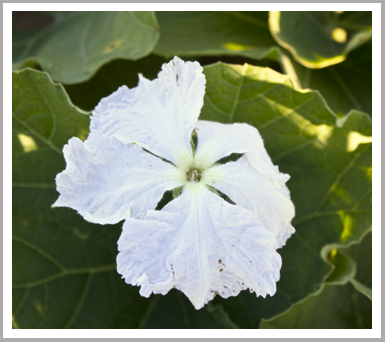Caramelized Blue Jarrahdale Pumpkin Butter, Infused with Orange and Bay
 When I planned my garden this year, I was looking forward to growing Winter Squash Marmellata, as it's known to the Italians, and Jaune Gros de Paris, as it's known to the French.
I was intrigued hat this variety was used for making jam in Italy. In my neck of the woods, pumpkin jam is not very common. I like the flavor of pumpkin, and I tired of tasting pumpkin pie in everything pumpkin around here.
When I planned my garden this year, I was looking forward to growing Winter Squash Marmellata, as it's known to the Italians, and Jaune Gros de Paris, as it's known to the French.
I was intrigued hat this variety was used for making jam in Italy. In my neck of the woods, pumpkin jam is not very common. I like the flavor of pumpkin, and I tired of tasting pumpkin pie in everything pumpkin around here.
My garden didn't do well, and I did get a early, small pumpkin which was rotten. Pumpkin jam, it seemed, at least from this variety, wasn't going to happen this year. One day however, day, good people at The Framed Table asked what flavors we were looking forward to this fall. I volunteered roasted pumpkin marmalade. I knew I could count on my farm stand having Blue Hubbard squash, a solid pie variety, and they do carry some Cheese Pumpkins, so I took a ride over to see what I could find.
 When I got there, my eyes immediately locked on the Blue Jarrahdale depicted in the photo on the left. Even thought I had no idea what kind of pumpkin it was, my gut told me it was good. I asked if they knew what kind it was, they didn't, so I was off to Google to ask for help.
When I got there, my eyes immediately locked on the Blue Jarrahdale depicted in the photo on the left. Even thought I had no idea what kind of pumpkin it was, my gut told me it was good. I asked if they knew what kind it was, they didn't, so I was off to Google to ask for help.
The Blue Jarrahdale is a New Australian heirloom. It's a cross between a Blue Hubbard Squash, and the Cinderella Pumpkin, which it is said was the inspiration for the pumpkin in Cinderella. The Blue Jarrahdales run from 10-20 pounds, they have a very hard exterior, a sweet orange flesh, and a stringless texture. It's a good, manageable size for cooking,great balance of flavor and sweetness, and the texture is superb. It has a hard skin, be careful cutting it, a small seed cavity, and is stringless.
I knew I wanted to caramelized it, which would require a sweetener. I've seen coconut sugar around recently, and I did some research about it. The glycemic index is low, which means it sweet without spiking your blood sugar when consumed, and it's packed fulled of nutrients. Livestrong.com provides the nutritional analysis here. First and foremost, food is nutrition. I wanted to create a sweet treat recipe that's packed with nutrients, and with a minimal amount of ingredients. I was able to do that, and the result is the recipe below.
Since I wanted to get away from the whole pumpkin pie flavor profile, I went with a flavor combination that's a favorite of mine, orange and bay leaves. Ever since I grew my first bay plant, I've been hooked on fresh bay leaves, or the dried version of the leaves I grow. As it is with most food, there's a world of difference between the fresh and the packaged variety on a store shelf. I find the flavor of bay leaf is a nice compliment to orange.
A few notes first, while I was fortunate to find a Blue Jarradale, if you can't find one, I'm sure any pie squash or pie pumpkin will work. If you can find a Blue Hubbard squash, which is fairly common, use that. If you can't find a fresh pumpkin, canned pumpkin should work. The caramelization steps would be different.
I used fresh squeezed Valencia oranges. They have a great flavor, but use what you can source easily. Same thing with the sweeter. If coconut sugar is not an option, go with brown sugar. Also, if dried bay leaves are all you have, use them.
The butter is finished in a crock pot. For pumpkins and squash, I like the steaming feature that the crock pot offers. The texture is well suited for this slow, moisture-based cooking process. Since the crock pot slowly adds a flavor-induced moisture, a nice rick texture is created for finishing with a blender stick.
Caramelized Blue Jarrahdale Pumpkin Butter, Infused with Orange and Bay
Aproximately 7 lbs. of pumpkin 1 cup organic, gmo free coconut sugar, more if needed 1.5 cups fresh squeezed orange juice 2 fresh bay leaves, 3 if dried 1 orange for rind, about 1 tbspn. needed Parchment paper
Yield 4 quarts
- Cut pumpkin in half, remove seeds and stem. Cut into equal size pieces leaving the skin on. (See seed saving notes below.)
- Coat the cut sides of the pumpkin with the coconut sugar. If the flesh is very firm, and the sugar is not adhering to it, scrap the flesh a little and than apply the sugar. Once the sugar starts absorbing the moisture, it will become tacky. The sugar will stick better.
- Put in a bowl, or large pot with a lid, cover and let stand overnight on a counter.
- Place the organe juice into a small bowl, tear the bay leaves and place into the juice. Add the orange rind into the juice/bay leaves mixture. Cover and place in the refrigerator overnight.
- Next morning, preheat oven to 400 degrees. Line baking sheets with parchment paper.
- Place orange juice mixture into a crock pot, put the lid and use low setting.
- Take the sugared pieces of pumpkin out of the bowl or pot, and place on the lined baking sheets.
- Pour syrup from the bottom of the bowl or pot into the crock pot.
- Roast the pumpkin for approximately 30 minutes, or until desired level of caramelized is reached.
- Remove from oven, remove skin from caramelized pieces, they will be very hot, be careful, and place into the crock pot.
- Let the pumpkin and orange juice mixture cook in crock pot for two hours, occasionally stirring and mashing with the back of a spoon.
- Finish with blender stick to create a smooth, creamy and rick texture.
- Process in jars, or plastic bags for freezing.
Seed saving note – Pure seed is extremely important to the biodiversity of our planet. GMOs are dangerous, and one way to combat them is to save seeds. Pumpkin and squash seeds are nutrient dense, so there's another good reason to save them. Whether you save them for sowing or food, the process is a simple one.
Seed Saving Notes
For sowing, remove the seeds, rinse in a strainer under warm running water, and remove any flesh. Dry on a paper towel, set out on a board or screen to dry completely. To save for the next season, place in an envelope, and keep in a cool, dry place until ready to plant. An airtight jar in a refrigerator is an option. Keep in mind though, if you use the refrigerator, and lose power for an extended period of time, the humidity and heat will build up, signalling the seeds to sprout.
For roasting, clean the seeds as above. Drain well. Preheat oven to 275 degrees. Spray a cooking a cooking sheet with oil, or line one with foil and spray with oil. Spread the seeds out in single layer, and salt them, or season them as desired. Place in oven, until they turn a light brown. Keep an eye on them, timing will vary from 10 to 20 minutes.
Now that this is posted, I'm on my way back to the farm stand to scoop up anymore of these Blue Jarrahdales I can find. They are good keeper, up to a year, from some of the references I've read. With a span like that, who needs a can?

